'From A to Z'
Forty years later
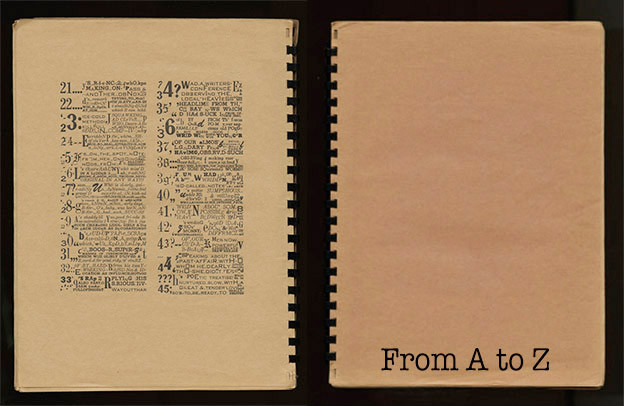
“Quick, tell me the differences among Olson, Williams, and Pound.” Placed at the bottom of the “Introduction,” this line speaks volumes about the encounter between modern poetry and print publication that is documented in the bibliography-a-clé, From A to Z. Composed of letterpress type, forty-eight drawers of individual metal letters each used once to form a text that made sense, the book contains twenty-six (each lettered alphabetically) poems attributed to poets who had been part of the Bay Area in the mid-1970s (Leslie Scalapino, Ron Silliman, Clark Coolidge, Tom Raworth, Stephen Rodefer, Geoff Young, Betsy Davids, David Bromige, Tom Clark, etc.). The work is a hypertext in print, each reference and element of the paratextual and textual materials cross-references marginal notes, the alphabetic key to the characters, and the many interwoven threads in which information about relationships, power plays, critical exchanges, and personal/professional engagements is embedded. Complexly structured, the work is entirely consistent, with each poet’s identity and connections with others made evident through the web of references and information points (age, income, education, character traits, and other matters). All can be tracked and extracted across the interlinked pieces of highly formatted text and paratext.
From A to Z was published/printed in 1977. The book was a long year in the making, and as a work that was essentially an enormous scrabble game, it required a number of procedural steps for its realization. The most coherent (looking) sections were the ones written and set first. Then the “sorts” had to be used up by making $ubstitution$, f/puns, us!ng punctuation, and abbrev:at:ns, among other tricks.
Written under constraint — every single letter was to be used once — it was written in advance of any knowledge of OuLiPo (n.b. La Littérature Potential was only published in 1973, with translations not appearing until the mid-1980s). In the mid-1970s, the cultural diffusion of experimental French writing was still limited, even if Paul Auster and Lydia Davis, both occasional visitors to the West Coast Print Center where this book was made, were translating André du Bouchet and Edmond Jabès. But the esoteric metaphysics of such poetics was a far cry from algorithmic composition, or any of the other process-driven approaches that would become prevalent in conceptual writing twenty years (!) later. The Book of Questions would have had no place in inspiring this project, but Georges Perec’s La Disparition (1969, translated 1996) and Christian Bök’s Eunoia (2001) are kindred works. The first was unknown to me at the time, the second written almost twenty-five years later.
As a pseudobibliography, the work took its inspiration from a project by Alastair Johnston, a colleague who was completing work on a study of the Auerhahn Press, one of the major publishers of Beat literature in San Francisco in the 1960s. The idea of tracking documents and archival material as a way to compose a study of literary life was irresistible. Making up a set of such ephemeral items was a game too tempting not to play, especially from the vantage point of having been the staff typesetter at the West Coast Print Center for more than a year, and becoming immersed in the aesthetic contests that played out in subtle and not-so-subtle terms. The emergence of Language Poetry, the influence of late Surrealism, the persistence of the lyric, and the commitment to formal experiment across a range of poetic practices all had their place in that scene. Charismatic and persuasive figures, forceful in their beliefs, powerful in their convictions, pushed us to “define our terms” in ways that were exhilarating — when they were not exhausting and brutal. I was a novice in the scene, a worker in the print shop where I typeset whatever came across the transom and met the many writers whose books were being printed for the many small presses flourishing at the time.
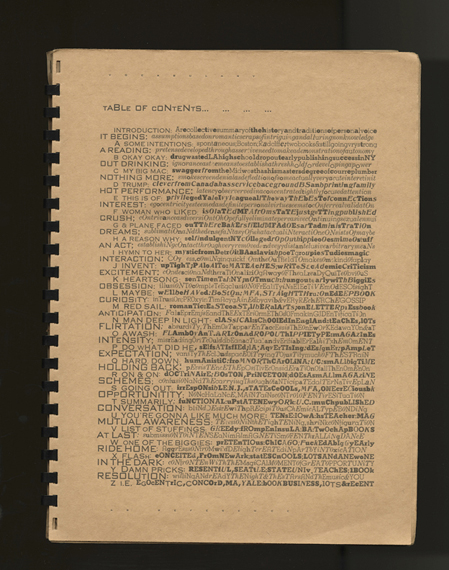 Figure 1: Table of Contents showing composition that alternates narrative and poem titles.
Figure 1: Table of Contents showing composition that alternates narrative and poem titles.
From A to Z is highly structured, and the process of letterpress composition was a necessary consideration in the organization. The relation between textual production and letterpress composition was iterative: compose a text, set it and edit in the composing stick, return to the case, assess the remains or “sorts” still left, set those, repeat until all letters, punctuation, and most numbers were used.
The book contains a preface, table of contents, header, footer, endnotes, a key to the characters, and the story of character A’s crush on character Z. The central content of the work is the collection of twenty-six poems, each by a different character (pun intended), whose literary style is reinforced typographically. Elegant serif faces for the poets of personal epiphany and interior life. Copperplate gothic for the procedural writers. A weird black-letter for the quasi-Surrealists or adherents to the classical tradition. Blunt sans serif for the swaggering machismo texts, and a delicate serif font for the soft-voiced ones. So, Clark Coolidge’s text is set in uncial Copperplate, “This is. Of. Something is / of this & out of. Some is / this out of. Some thing / that writes and so self / is out of this writing.” Barrett Watten’s “Invent” in Stymie bold, “This thing is defined by lines. / One straight decision follows another.” Leslie Scalapino’s “The Woman Who Liked to Lick” is set in a compressed humanist font, “In the wet pants of animals resides / the fragile whine of constant fear. Sucking.” And “Heartsong,” the confessional verse of a now-anonymous woman poet is rendered in Brush, “In my little heart I held / A precious bit of pain.”
A fully annotated version of this work would exhaust any reader’s patience. The title page announces the themes and structure. The page is framed by a header and footer in six-point Gothic spelling out, “The Politics of Language.” The subtitle following “From A to Z” reads: “Our An (Collective Specifics)” a pun on Auerhahn abstracted to a linguistic paradigm, followed by “an im partial bibliography” that embodies the paradox of objectivity and bias in the double entendre enabled by the space introduced in the word. The final subtitle, “Incidents in a non-relationship: or how I came to not know who is” also contains a pun — “who is” for “Lewis” MacAdams, my crush object. This level of embedded complexity weaves throughout this entire book. Nearly every page and comment, marginal note and other material, has these many multiple levels of fractured, allusive, layered meanings. No wonder it has had few readers and little commentary (of course, it was out of print for almost four decades …).
In brief, then, here is a basic guide to the work. The dedication page (“For My Freds of Ledders” was composed towards the end of the project, using up the remains of twelve-point type in a paragraph of mixed-font mélange in which each character is identified by number. The “Table of Contents” which follows contains an interlinear guide to the book: themes of the crush, from “It Begins” to “Resolution,” alternate with the list of poem pages: “A Some Intentions.” Each title is followed by a string of text that gives slightly deformed information about the author, so, for Leslie Scalapino’s entry, “Woman Who Liked: isolated MFA from State just getting published” and for Tom Raworth, “Trump: clever from Canada has service background BS and printing family.” The “Introduction” describes the poetic scene, an analysis of contemporary influences: “It’s [sic] tone was spawned in the breach between the rigid framework of Q’s blunt humanism and E’s procedural formalism.” E was Clark Coolidge and Q, David Bromige. The text continues: “P’s contempt of strict traditional dogma, which was an affrontry [sic] to E and more particularly to J, who felt that P should not ignore […]” and so on.
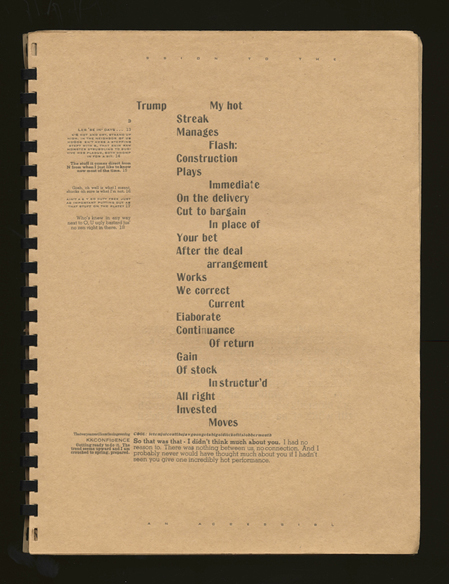 Figure 2: The “Tom Raworth” page.
Figure 2: The “Tom Raworth” page.
Then the twenty-six poems begin. Here a quick anatomy of the page format and the indication of semantic coding in each zone is helpful: a) main text/poem set in display size; b) marginalia that is supposedly excerpts of overhead conversations, notes, letters, etc. among the characters, consistently identified by their letters; c) the running header and footer; d) the verso of the page with the “bibliographical” information about the book from which the poem is taken; e) the narrative account of the relationship of characters A and Z, with its six subdivisions.
a) Character D, based on Tom Raworth, is represented by a poem titled “Trump.” Raworth’s Ace had been published in 1974, and this spare text was created in imitation, with short hard lines: “My hot / Streak / Manages / Flash.”
b) Marginal notes are full of puns: “Les ‘be in’ Days … 13” and “Who’s knew in any way next to O, U ugly bastard jus nozen right in there. 18.” Numbers correspond to explanatory endnotes, harder to read than the marginalia: “13: P’s miss –ake on aging K who maybe muss have uh been beau’y iN her prime anyway inscribd on fly leaf of P’s copy of … sAm Ol Numb.r II volumn.” Remember that these endnotes, typeset insanely, were the last bits of the book set, using up the final sorts in the cases.
c) Header and footer are fragments of the ongoing statements on Politics of Language.
d) On the verso of the sheet, a bibliographical note describes the volume from which the poem is meant to be taken. “Actual Amusements Trmp, $1.- 58 pg. SANS 18PT. 26LNS.x 41wds.” The cost of the book is a ranking of economic status, I guess I imagined Tom without funds, and aged 58, when in fact he was considerably younger at the time. A punning blurb describing the volume follows: DEVLOPED iNNLLEcT & AppLIed sYNTHEsis OF dIReCT PERsONaL …EpRiANcZ .” All substitutions, elisions, and typos are the result of having to make do with what was left in the case after setting the poem on the recto.
e) Below the poem, on each of the twenty-six main pages, the tale of the “non-relationship” between A and Z unfolds. Character A had set out, unsuccessfully, to seduce character Z, and the pieces of text that run below each poem detail the events of this “non-relationship” in six, typographically distinct, separate blocks, each providing a facet of the scene: psychic/somatic conditions, mood, an unspoken statement, mood/atmosphere, and the narrative spoken by A to Z.
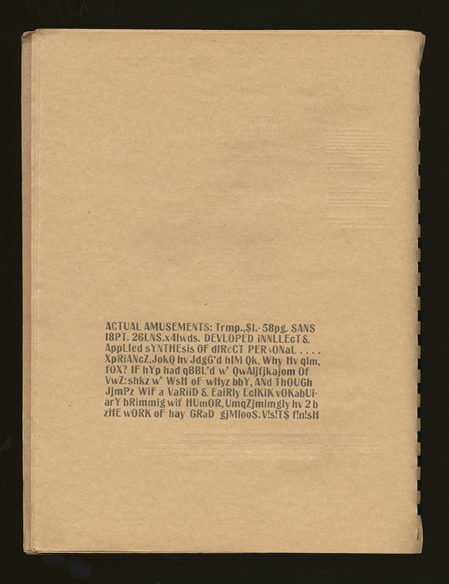
Figure 3: Verso of the “Raworth” page.
On the final page, a “Key to Abbreviations Used in this Book” names a disease each character deserves to have and description of the poet: D, Raworth, was not spared any more than any other writer: Gout was the ill to plague him, and he was described as “a shrewd old bugger, playing infantile from his sense of the absurd — enormous bushy eyebrows and a grizzled beard — intense eyes full of humor.” In many cases, genders were reversed to make identification more difficult. Thus, for Leslie Scalapino, the description reads: “Nebbishy little guy, tiny buns, small and shy with a high voice — sweet actually, but timid and oversensitive.” As to Lewis, (having sentenced my character, A, to Diarrhea) I punished him with “Constipation,” and described him as “Very Ivy league, greying prematurely and into the distinction it lent him — good family, good education, & good prospects, nice inheritance — poor fellow.”
From A to Z is a virtuosic letterpress work: the sheer skill of typesetting in the final pages, where notes are explained in elaborate paragonnage (multiple sizes/fonts in a single form) across a set of columns, demonstrates features of metal type that would be exceedingly difficult to duplicate in digital approaches. The fact that the writing occurred with the setting in these final pages is almost unfathomable, except that it would have been impossible to compose any other way, since the language came directly from what was left in the drawers. The hypertextual, interlinked, social media portrait of the scene is its own sui generis accomplishment. The writing and the works of individual poetry have their humor as parodies. But the main point is to understand that the book was written and composed as a book — it is writing in the codex format start to finish, not as a work that ends up in a book. Every word, sentence, scrap of text, is given its value by its position in the format, which inflects its meaning.
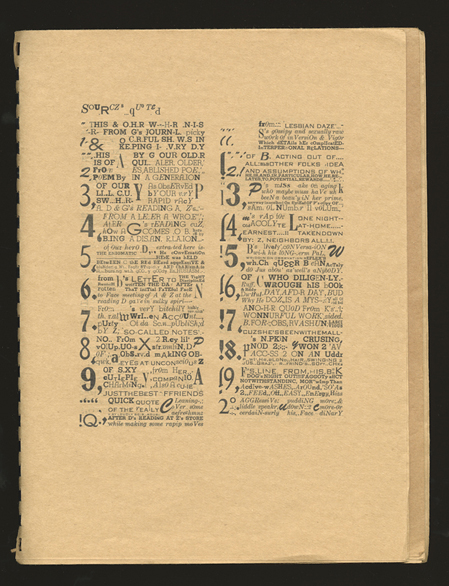 Figure 4: Final notes “explaining” marginalia.
Figure 4: Final notes “explaining” marginalia.
Much information and much clever intensity reside in these pages. I did not spare myself praise in the writing of a fake review, printed on newsprint and torn to look as if it had appeared in The New York Times: “This remarkably brilliant work, the culmination of almost six years of persistent scholarly research through ephemeral and indeed, at times, nearly nonexistent archives, is fully reflective of the inspired dedication which necessarily is the sustenance of such a labor.” The facsimile edition to the book contains a key to the characters depicted, but the puzzling out of intricacies, relations, and betrayals still requires a reader to engage in this text, not page by page, or line by line, but literally letter by letter.
Author’s note: From A to Z was reissued in facsimile by Columba College’s Center for Book and Paper, with an essay about the project and a key to the characters, and can be purchased here.
The original can be viewed in its entirety here.